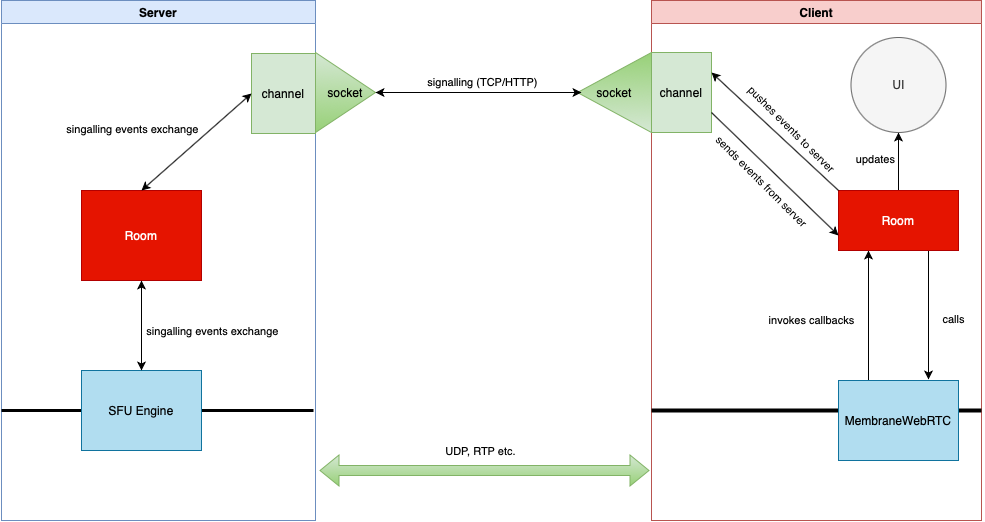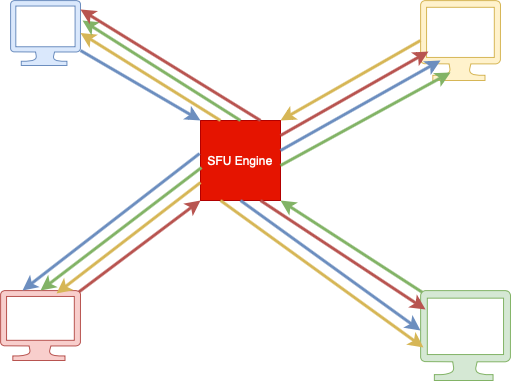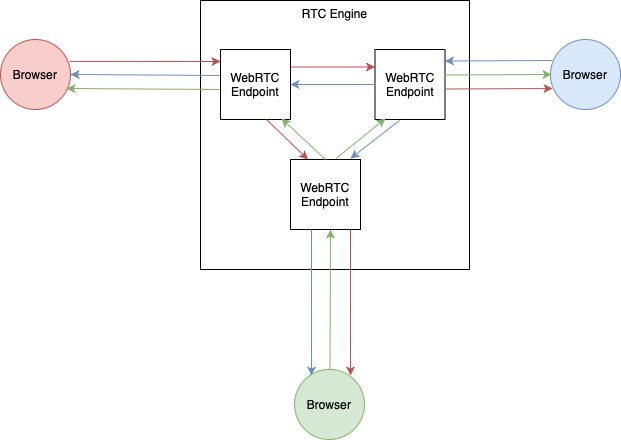System architecture
Hang on for a moment! I know that after slipping through the tons of the documentation you are really eager to start coding, but let’s think for a moment before taking any actions. What do we want our application to look like? Can we somehow decompose our application?
Sure we can - as in each web application we have two independent subsystems:
- server (backend) - written in Elixir, one and the only for the whole system. It will spawn a
Roomprocess for each of the rooms created by the users, which will handle signaling and relay media among the peers in the room. - client application (frontend) - the one written in form of JS code and executed on each client’s machine (to be precise - by client’s web browser). It will be responsible for fetching the user’s media stream as well as displaying the stream from the peers.
We might need something else than the plain Elixir standard library…
Ugh…I am sure till now on you have already found out that media streaming is not that easy. It covers many topics which originate from the nature of reality. We need to deal with some limitations brought to us by the physics of the surrounding universe, we want to compress the data being sent with the great tools mathematics has equipped us with, we are taking advantage of imperfections of our perception system… All this stuff is both complex and complicated - and that is why we don’t want to design it from very scratch. Fortunately, we have access to the protocols and codecs - ICE, RTP, H264, VP9, VP8, Opus, etc. - which already solves the aforementioned problems. But that’s not enough - those protocols are also complicated and implementing or even using them requires digging into their fundamentals. That is why we will be using the framework that provides some level of abstraction on top of these protocols. Ladies and gents - let me introduce to you - the Membrane framework.
What does Membrane framework do?
Seek at the root! Membrane documentation
Membrane framework structure
It would be good for you to know that the Membrane Framework consists of the following parts:
- Core
- Plugins
We will be using one of its plugins - RTC Engine plugin, which has both the server part (written in Elixir) and the client’s library (written in Javascript). This plugin provides both the implementation of the Selective Forwarding Unit (SFU) and the signaling server logic (with the usage of ICE protocol).
System scheme
The diagram below describes the desired architecture of the events passing system which is the part of the system we need to provide on our own:

And here is how the SFU Engine will relay multimedia streams:

In terms of media streaming, our server will be a Selective Forwarding Unit (SFU).
Why do we want our server to be a Selective Forwarding Unit? The reason is that such a model of streaming data
among peers allows us to balance between the server’s and client’s bandwidth and limit CPU usage of the server.
RTC is receiving streams from each of the peers and passes each of these streams to each of the other peers.
Server
As pointed out previously, the server will have two responsibilities - the first one is that it will work as a signaling server, broadcasting event messages among the peers.
The second one is that it will act as a streaming server.
A Selective Forwarding Unit implementation in the Membrane Framework can be achieved with RTC Engine plugin, which is capable of both the signaling and streaming media.
In the tutorial, we will wrap the RTC Engine and provide business logic in order to add video room functionalities.
The server will consist of two components holding the logic and two components needed for communication.
The communication will be done with the use of Phoenix sockets and that is why we will need to define the socket itself and a channel for each of the rooms.
The “heart” of the server will be RTC Engine - it will deal with all the dirty stuff connected with both the signaling and streaming. We will also have a separate Room process (one per each of the video rooms) whose responsibility will be to aggregate information about peers in the particular room.
RTC Engine will send event messages (e.g. :new_peer or :sfu_media_event messages) on which reception the Room process will react, for instance, by dispatching them to the appropriate peer’s channel. Channel will then send those messages to the client via the socket.
Messages coming on the socket will be dispatched to the appropriate channel. Then the channel will send them to the Room’s process, which finally will pass them to the RTC Engine. RTC Engine will receive them inside its endpoints since each peer will have a corresponding endpoint in the RTC Engine, as presented on the diagram below:

Note that the scheme is simplified and does not show elements (i.e. channels) that are in between the RTC Engine and the peers’ browsers If you want to find out more about the inner architecture of the RTC Engine, please refer here.
Media transmission will be done with the use of streaming protocols. How this will be performed is out of the scope of this tutorial. The only thing you need to know is that RTC Engine will also take care of it.
Client
Each client’s application will have a structure reassembling the structure of the server.
In the Room instance, the client will receive messages sent from the server on the associated channel. The Room will call the appropriate methods of MembraneWebRTC object.
At the same time, MembraneWebRTC object will be able to change the Room’s state by invoking the callbacks provided during the construction of this object. These callbacks as well as the Room object itself will be able to update the user’s interface.
Be aware that MembraneWebRTC object will also take care of the incoming media stream.
NEXT - Server’s communication channels
PREV - Environment preparation
List of contents
List of tutorials